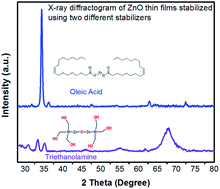Effect of sol stabilizer on the structure and electronic properties of solution-processed ZnO thin films†
Abstract
ZnO is an increasingly important wide bandgap semiconductor for optoelectronic applications. Solution processing provides a facile and inexpensive method to form ZnO thin films with high throughput. The sol stabilizer used in the solution processing of ZnO functions variously as a sol homogenizer, chelating agent, wettability improver and capping agent. In spite of its obvious importance in influencing ZnO film properties, a restricted set of short chain alkaline sol stabilizers have been used in prior reports. We examined the effect of six different sol stabilizers, including acidic and longer chain species, along with a recipe without any stabilizer, on the grain size, crystallographic texture, and resistivity of solution processed ZnO films on thermal oxide-coated silicon substrates, and found large variations in the structural and electrical properties as a consequence of the choice of sol stabilizer. We found that ZnO films formed using oleic acid as the sol stabilizer possessed a strong (002) preferred orientation with a Lotgering factor as high as 0.86. The key insight we obtained is that the sol stabilizer strongly influences the film surface area and activation energy barrier for inter-grain transport. We comprehensively studied the steady state and transient behavior of ZnO films deposited using different stabilizers and compared their lifetime and mobility-lifetime products. When exposed to illumination, the conductivity of the deposited films increased by several orders of magnitude. This is attributed to the trapping of the nonequilibrium holes by the surface adsorbed oxide species, which produces equivalent number of excess electrons in the conduction band. Impedance spectroscopy and C–V measurements were performed to calculate the doping of the ZnO thin films. ZnO thin film transistors were also fabricated and the effects of the sol stabilizer on the different parameters of the TFT like mobility and threshold voltage were investigated.



 Please wait while we load your content...
Please wait while we load your content...